How To Consolidate Debt
Having a lot of debt certainly makes our lives uncomfortable. Debt also often works like a virus. In fact, after owing for one purpose, there will be another attractive offer to re-owe it. If the debt is still around credit card debt with small installments, or electronic goods purchase debt that is also small installments, maybe it can still be managed, but what if the debt you have is large? One way that can make it easier to repay large amounts of debt is by consolidating debt. The question is "how to consolidate debt"?
 |
| Picture: istockphoto.com |
The term consolidated debt seems to be present as an epiphany for those of you who have a lot of debt in large quantities. Even so, this debt consolidation is not a solution to pay off your debts, it's just that if applied to the financial problems of people who owe a lot, it can help facilitate the repayment of their debts.
Best Way To Consolidate Debt Without Hurting Credit
The meaning of the word Consolidation itself is merging. In the case of debt consolidation, the meaning is to combine several loans that are large in number, into one single loan. With consolidation, it is quite possible for people with a lot of debt, to combine them into one larger loan with a low-interest rate.
Several methods can be used to consolidate debt. The options may be limited depending on the type of debt, credit status, and any real estate assets a person has, including:
1. Credit Card Balance Transfer
Credit cards with high credit limits and promotional interest rates on balance transfers are good candidates for combining credit card balances with other high-interest rates into one account.
Combining balances below an interest rate lower than the average rate of an existing balance allows one to save money on interest and pay for one credit card instead of several.
Balance transfers usually don't count toward the cash bonuses, points, or introductory miles the card offers.
2. Debt Consolidation Loans
Lenders often offer "debt consolidation" loans that tend to be unsecured personal loans designed specifically to pay off debt.
Debt consolidation loans typically have a fixed interest rate and a repayment period for a more stable repayment term.
3. Student Loan Consolidation
This loan is specifically to consolidate multiple student loan balances into one loan with a single monthly payment.
This can be beneficial if you have multiple student loans with different services. These loan consolidations are available for both private and federal loans.
4. Home Equity Loans and Credit Limits
Home equity loans and lines of credit typically allow a person to borrow up to 80%-85% of his home equity. The loan option makes it possible to take a certain amount of money paid through a fixed payment over a certain period.
Home equity lines of credit are similar to credit cards in that a person has access to money whenever he needs it and only pays interest on the money borrowed.
Be warned, a series of fee payments need to be made to complete the home equity credit. Then the money from the loan or line of credit will be taken out and paid off the existing debt, whether credit card, personal loan or other borrowed money.
Home equity loans and lines of credit require using the home as collateral. If they don't pay the loan or credit limit back, a person could lose their home due to foreclosure.
5. Cash Mortgage Refinancing
Cash refinancing is a type of mortgage refinancing in which it will get a new mortgage that exceeds the amount owed on the first mortgage.
A new mortgage pays off the old one and can pocket the difference through cash. This money can be used the money to pay off existing debts, assuming what is approved to cover credit card and loan balances.
As a reminder, cash repayments are usually accompanied by closing costs.
Hopefully, this information about "how to consolidate debt" is useful and becomes a reference for those of you who want to settle your debts.

0 Response to "How To Consolidate Debt"
Post a Comment